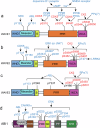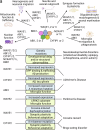The WAVE complex in developmental and adulthood brain disorders
- PMID: 39774290
- PMCID: PMC11799376
- DOI: 10.1038/s12276-024-01386-w
The WAVE complex in developmental and adulthood brain disorders
Abstract
Actin polymerization and depolymerization are fundamental cellular processes required not only for the embryonic and postnatal development of the brain but also for the maintenance of neuronal plasticity and survival in the adult and aging brain. The orchestrated organization of actin filaments is controlled by various actin regulatory proteins. Wiskott‒Aldrich syndrome protein-family verprolin-homologous protein (WAVE) members are key activators of ARP2/3 complex-mediated actin polymerization. WAVE proteins exist as heteropentameric complexes together with regulatory proteins, including CYFIP, NCKAP, ABI and BRK1. The activity of the WAVE complex is tightly regulated by extracellular cues and intracellular signaling to execute its roles in specific intracellular events in brain cells. Notably, dysregulation of the WAVE complex and WAVE complex-mediated cellular processes confers vulnerability to a variety of brain disorders. De novo mutations in WAVE genes and other components of the WAVE complex have been identified in patients with developmental disorders such as intellectual disability, epileptic seizures, schizophrenia, and/or autism spectrum disorder. In addition, alterations in the WAVE complex are implicated in the pathophysiology of Alzheimer's disease and Parkinson's disease, as well as in behavioral adaptations to psychostimulants or maladaptive feeding.
© 2025. The Author(s).
Conflict of interest statement
Competing interests: The authors declare no competing interests.
Figures




Similar articles
-
WAVE forms hetero- and homo-oligomeric complexes at integrin junctions in Drosophila visualized by bimolecular fluorescence complementation.J Biol Chem. 2010 Dec 17;285(51):40171-9. doi: 10.1074/jbc.M110.139337. Epub 2010 Oct 11. J Biol Chem. 2010. PMID: 20937809 Free PMC article.
-
Activation of Arp2/3 complex-dependent actin polymerization by plant proteins distantly related to Scar/WAVE.Proc Natl Acad Sci U S A. 2004 Nov 16;101(46):16379-84. doi: 10.1073/pnas.0407392101. Epub 2004 Nov 8. Proc Natl Acad Sci U S A. 2004. PMID: 15534215 Free PMC article.
-
Scar/WAVE drives actin protrusions independently of its VCA domain using proline-rich domains.Curr Biol. 2024 Oct 7;34(19):4436-4451.e9. doi: 10.1016/j.cub.2024.08.013. Epub 2024 Sep 26. Curr Biol. 2024. PMID: 39332399
-
Regulation of actin assembly by SCAR/WAVE proteins.Biochem Soc Trans. 2005 Dec;33(Pt 6):1243-6. doi: 10.1042/BST0331243. Biochem Soc Trans. 2005. PMID: 16246088 Review.
-
WAVE signalling: from biochemistry to biology.Biochem Soc Trans. 2006 Feb;34(Pt 1):73-6. doi: 10.1042/BST0340073. Biochem Soc Trans. 2006. PMID: 16417486 Review.
References
-
- Goley, E. D. & Welch, M. D. The ARP2/3 complex: an actin nucleator comes of age. Nat. Rev. Mol. Cell Biol.7, 713–726 (2006). - PubMed
-
- Krause, M. & Gautreau, A. Steering cell migration: lamellipodium dynamics and the regulation of directional persistence. Nat. Rev. Mol. Cell Biol.15, 577–590 (2014). - PubMed
Publication types
MeSH terms
Substances
LinkOut - more resources
Full Text Sources
Medical

